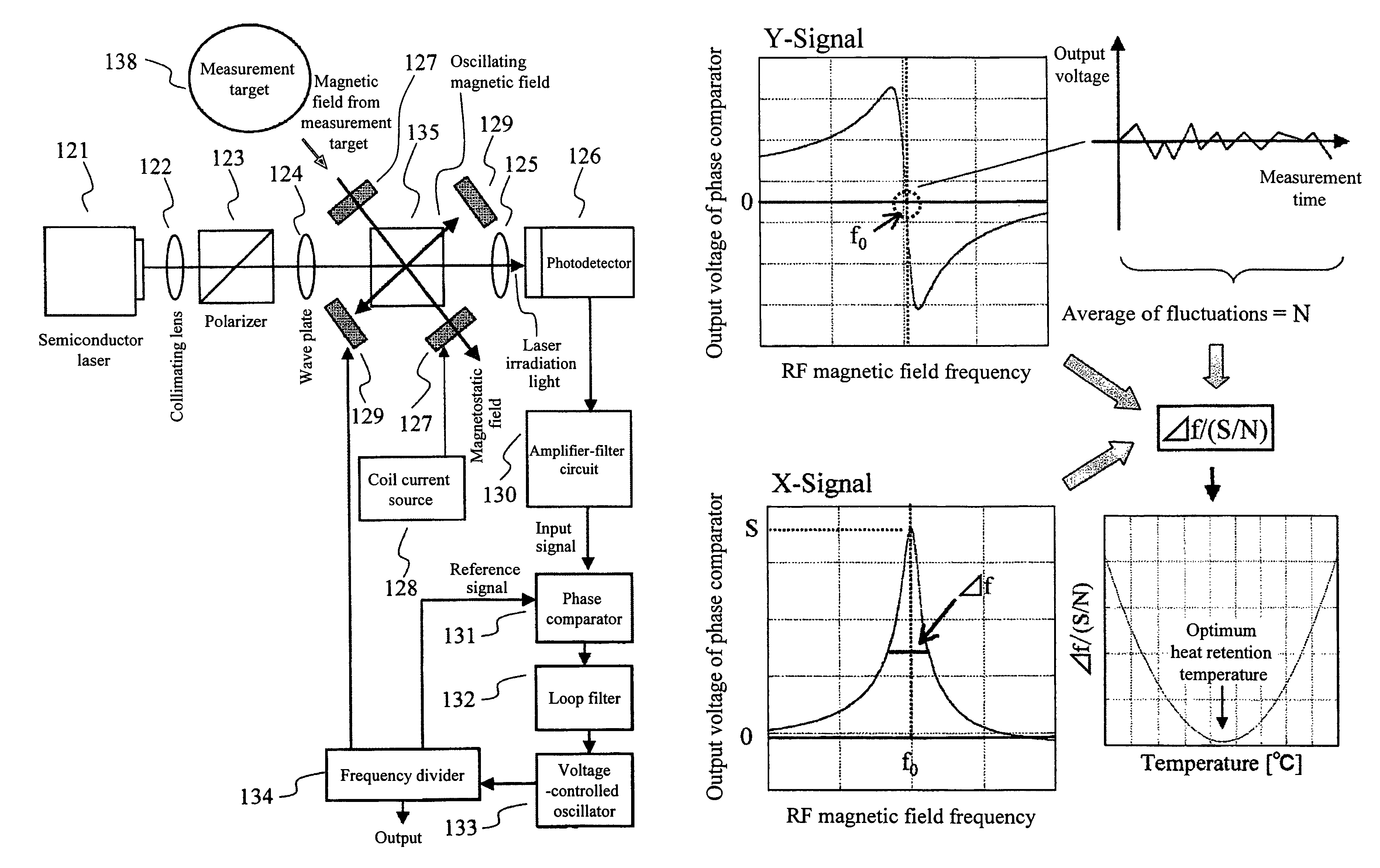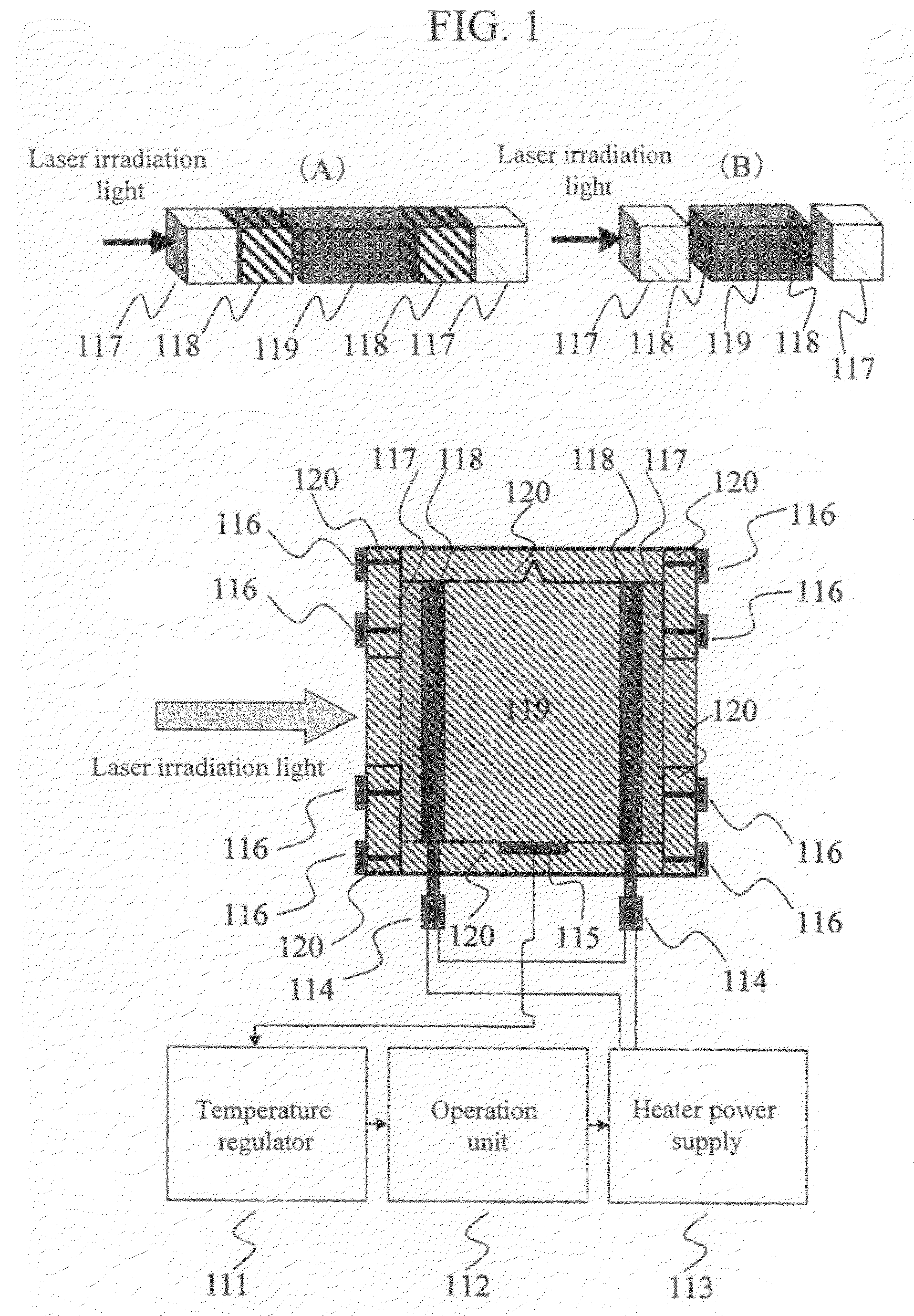Magnetic field measuring optically pumped magnetometer apparatus
a technology of optical pumping and magnetic field, which is applied in the direction of optical radiation measurement, instruments, and reradiation, etc., can solve the problems of lowering the accuracy of magnetic field measurement, requiring a long time to bring the cell to a desired temperature, and large periphery of the cell, so as to achieve quick cell bringing and enhance temperature stability
- Summary
- Abstract
- Description
- Claims
- Application Information
AI Technical Summary
Benefits of technology
Problems solved by technology
Method used
Image
Examples
example 1
[0067]Example 1 of the present invention will be described using FIG. 1.
[0068]First, as an example of FIG. 1(A), the transparent film heaters 118 are provided to the laser irradiation light passing-through parts of the vapor cell 119, and current is applied to the transparent film heaters 118, thereby retaining the heat of the vapor cell 119. It is preferable that the vapor cell 119 and the transparent film heaters 118 are not bonded with an adhesive, etc., so that they can be replaced when they are deteriorated.
[0069]Also, in order to prevent a heat retention efficiency decrease caused as a result of the transparent film heaters 118 or the cell windows of the vapor cell using the conductive glass (ITO) shown in FIG. 1(B) being directly exposed to external air, the heat-resistant glasses 117 are required for the laser irradiation light passing-through parts of the vapor cell 119, and the transparent film heaters 118 are required between the heat-resistant glasses 117 and the vapor c...
example 2
[0071]Example 2 of the present invention will be describe using FIG. 2. FIG. 2 shows an optically pumped magnetometer requiring a vapor cell heat retention system 135 according to the present invention, the system being a heat retention sensor part including a vapor cell heated by the transparent film heaters 118 shown in FIG. 1. Using the vapor cell heat retention system 135, the vapor cell 119 is heated to a desired temperature. Laser irradiation light from the semiconductor laser 121 is converted into circularly-polarized light via the collimating lens 122, the polarizer 123 and the wave plate 124, and the circularly-polarized light is irradiated to the vapor cell 119 to which a magnetostatic field is applied by the magnetostatic field application coils 127. At this time, a RF magnetic field is applied from the RF coils 129 in a direction perpendicular to the magnetostatic field application direction, and the laser irradiation light modulated by the RF magnetic field is detected ...
example 3
[0073]Example 3 of the present invention will be described using FIG. 4. As shown in FIG. 3, two vapor cell heat retention systems are required; one is used for a magnetic field measurement sensor, and the other is used for a reference sensor for determining the effect of current applied to the transparent film heaters 118.
[0074]Laser irradiation light from the semiconductor laser 121 is made to be parallel light by the collimating lens 122, and the laser irradiation light is split into two by means of a beam splitter 137 after it is converted into circularly-polarized light via the polarizer 123 and the wave plate 124. One of the laser irradiation light split into two is applied to the vapor cell 119 for the magnetic field measurement sensor, and the other is applied to the vapor cell heat retention system 135 including the vapor cell 119 for the reference sensor. Each vapor cell has the magnetostatic field application coils 127, and a magnetostatic field of the same strength is ap...
PUM
 Login to View More
Login to View More Abstract
Description
Claims
Application Information
 Login to View More
Login to View More - R&D
- Intellectual Property
- Life Sciences
- Materials
- Tech Scout
- Unparalleled Data Quality
- Higher Quality Content
- 60% Fewer Hallucinations
Browse by: Latest US Patents, China's latest patents, Technical Efficacy Thesaurus, Application Domain, Technology Topic, Popular Technical Reports.
© 2025 PatSnap. All rights reserved.Legal|Privacy policy|Modern Slavery Act Transparency Statement|Sitemap|About US| Contact US: help@patsnap.com



